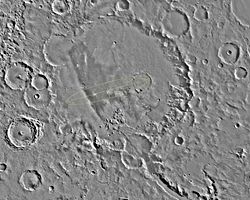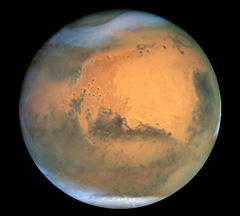Gusev crater
| Gusev | |
 Gusev crater, with Ma'adim Vallis snaking into it |
|
| Coordinates | 14.6° S, 175.4° E |
|---|---|
| Diameter | 175 km |
| Eponym | Matvei Gusev |
Gusev Crater is a crater on the planet Mars and is located at 175.4°E 14.6°S. The crater is about 170 kilometers in diameter and formed approximately three to four billion years ago. It was named after Russian astronomer Matvei Gusev (1826–1866) in 1876.
A channel system named Ma'adim Vallis drains into it that probably carried liquid water, or water and ice, at some point in Mars' past. The crater appears to be an old crater lake bed, filled with sediments up to 3000 feet thick. Some exposed outcrops appear to show faint layering, and some researchers also believe that landforms visible in images of the mouth of Ma'adim Vallis where it enters Gusev Crater resemble landforms seen in some terrestrial river deltas. Deltas of this nature can take tens or hundreds of thousands of years to form on Earth, suggesting that the water flows may have lasted for long periods. Orbital images indicate that there may once have been a very large lake near the source of Ma'adim Vallis that could have provided the source of this water. It is not known whether this flow was slow and continuous, punctuated by sporadic large outbursts, or some combination of these patterns.

More recently, satellite images showed the trails of dust devils on Gusev Crater's floor. The Spirit rover later photographed dust devils from the ground, and likely owes much of its longevity to dust devils cleaning its solar panels.
On January 3 2004, Gusev Crater was the landing site of the first rover in NASA's two Mars Exploration Rovers, named Spirit. It is hoped that the numerous smaller and more recent craters in this region will have exposed sedimentary material from early eras, although at first the region proved disappointing in its lack of available bedrock for study on the flat lava plains of the crater, Spirit's landing site. She eventually arrived at the Columbia Hills, however, and rocks examined in that region show that the Columbia Hills did have small amounts of briny (salty) water interacting with them in ancient times,[1] though nowhere near as much as Meridiani Planum, the landing area for Spirit's twin, Opportunity.
Contents |
Features within Gusev
Hills
- The Columbia Hills is a range of low hills 3 km from Spirit's original landing site; Spirit is currently exploring them
- Husband Hill is one of these hills
- McCool Hill is the tallest of the Columbia Hills
- Larry's Lookout is within Columbia Hills
- The Apollo 1 Hills are three widely-spaced hills 7-14 km away from Spirit's landing site
Craters
- Bonneville is a 200-metre crater visited by Spirit
- Crivitz crater is a smaller crater located within Gusev
- Thira crater is a crater located within Gusev, and could be seen from the summit of Husband Hill
Other
- Sleepy Hollow is a shallow depression near Spirit's landing site
- Adirondack is the name of the first rock visited by Spirit
- Home Plate is a layered geological feature recently studied by Spirit
See also
- Spirit rover for Spirit's continued journey within the Gusev crater
- Geography of Mars
References
External links
- Google Mars zoomable map - centered on the Gusev crater
|
||||||||||||||||||||||||||||||||||||||||||||
